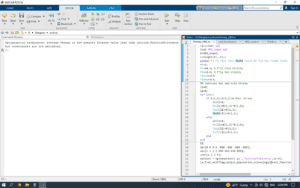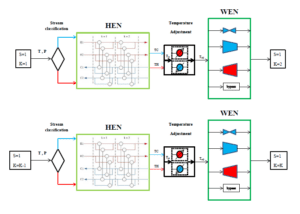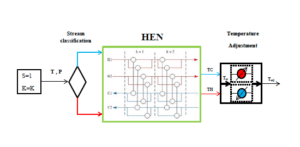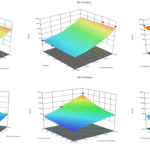Introduction
The Importance of Energy Optimization in Process Industries
Process industries, including oil, gas, and petrochemical sectors, consistently face numerous challenges related to energy consumption. Implementing advanced energy management strategies plays a crucial role in reducing operational costs, increasing efficiency, and minimizing environmental pollutants. One of the most effective approaches in this domain is the utilization of Work and Heat Exchange Network (WHEN), which enables the optimal management of energy flows within an industrial unit.
Work and Heat Exchange Networks (WHEN)
Work and Heat Exchange Networks (WHEN) comprise a coordinated set of process equipment such as heat exchangers, turbines, compressors, and pumps designed to optimize energy flows. By managing energy effectively, these networks facilitate waste reduction, energy recovery, and the efficient distribution of work and heat, ultimately leading to lower operational costs.
The Role of Simulation and Modeling in WHEN Optimization
Given the complexity of industrial systems, modeling and simulation serve as powerful tools for analyzing the performance of energy exchange networks. In this project, conducted for Jam Petrochemical Company, MATLAB software was employed for the modeling and simulation of the WHEN system. This simulation allows for evaluating various scenarios, analyzing the impact of parameter variations, and providing the most effective optimization solutions.
Project Objectives
Optimal Design of Work and Heat Exchange Network (WHEN)
The primary objective of this project is to design an optimized Work and Heat Exchange Network (WHEN) system that minimizes energy consumption and enhances system efficiency. The network involves the interconnection of industrial equipment such as turbines, compressors, and heat exchangers, which must be configured to ensure optimal energy distribution.
Performance Analysis of Process Equipment
A key aspect of this project involves assessing the performance of various equipment, including:
- Compressors: Evaluating gas compression levels, isothermal efficiency, and the impact of inlet and outlet pressures on energy consumption.
- Turbines: Analyzing mechanical energy transfer, pressure drop, and overall system efficiency.
- Heat Exchangers: Studying heat exchange efficiency, energy utilization, and minimizing heat loss across various process streams.
Optimization of Work and Heat Distribution
Through the analysis of operational data, the optimal mechanical and thermal energy distribution among different equipment is achieved. This process includes:
- Calculating the energy requirements for optimal equipment performance.
- Conducting numerical modeling to evaluate the impact of pressure and temperature changes on network performance.
- Implementing mathematical algorithms for optimizing work and heat flow.
Implementation of Mathematical Models and Optimization Algorithms in MATLAB
To achieve the best network structure, advanced mathematical models and optimization algorithms were developed using MATLAB. This modeling process includes:
- Dynamic simulation of the network to analyze its performance under various operational conditions.
- Numerical methods to solve energy transfer equations and assess system stability.
- Multi-objective optimization to reduce operational costs and improve equipment efficiency.
Analysis of Thermal and Mechanical Flows Using Engineering Software
In this project, data related to thermal and mechanical flows were extracted from engineering software such as Aspen Plus and used for model analysis and optimization. The key activities in this section included:
- Determining the heat capacity of various streams and analyzing their impact on energy exchange processes.
- Assessing the effects of pressure and temperature variations on overall system performance and predicting dynamic equipment behavior.
- Evaluating different operational scenarios to identify the most optimal working conditions.
Significance of Project Implementation at Jam Petrochemical Company
As one of the largest industrial units in the country, Jam Petrochemical Company prioritizes energy consumption optimization. The implementation of this project has not only improved energy efficiency within the company but has also provided a model for other petrochemical and refining industries to optimize Work and Heat Exchange Networks (WHEN).

The findings of this project demonstrate that the WHEN approach can be utilized for energy optimization in various industries, leading to significant cost reductions and improved efficiency.
Methodology
Analysis of Work and Heat Exchange Network (WHEN)
Initially, the work and heat exchange systems within Jam Petrochemical Company were identified and analyzed. Various work and heat streams were classified based on operational requirements, considering factors such as inlet and outlet temperatures, pressure levels, and the recoverable energy in each stream. Preliminary analysis indicated significant optimization potential in mechanical and thermal energy pathways.
Using MATLAB for Modeling and Analysis
Due to the complexity and multi-variable nature of industrial processes, MATLAB was used for system modeling. MATLAB offers advanced tools for thermodynamic analysis, solving nonlinear equations, and optimizing processes. In this phase:

- Energy transfer equations were modeled based on mass and energy conservation principles.
- Different operational scenarios were analyzed using MATLAB and compared with real-world data.
- Model stability and sensitivity were examined under varying pressure, temperature, and flow rates.
Network Design and Simulation
Following the initial modeling, the Work and Heat Exchange Network (WHEN) simulation was executed, including:
- Defining optimal streams for heat and work exchange between different equipment.
- Analyzing pressure increase and reduction processes in compressors and turbines.
- Utilizing Aspen Plus software data to enhance modeling accuracy and validate simulation results.
- Developing control and optimization strategies to minimize energy loss and improve network efficiency.


Selection of Optimal Equipment for Energy Optimization
A crucial part of this study involved selecting the most suitable equipment for enhancing network efficiency. This phase included:
- Evaluating the performance of compressors, turbines, and heat exchangers to determine the efficiency of each component.
- Comparing available market equipment based on criteria such as operational costs, lifespan, and energy efficiency.
- Assessing capital investment and analyzing the impact of equipment replacement on long-term energy consumption reduction.
Refining and Optimizing the Simulation Model
After executing the initial modeling and simulation, necessary refinements were applied based on selected energy flow analyses. In this phase:
- Key parameters such as pressure, temperature, and flow rate were adjusted to optimize the model.
- Mathematical relationships within the model were refined using data extracted from Aspen Plus.
- Various operational scenarios were tested and compared to identify the best working conditions.
By executing these steps, the final model successfully provided an optimized WHEN system that reduced energy consumption and enhanced equipment efficiency. The findings from this study offer a comprehensive approach to energy management and optimization in petrochemical industries, serving as a successful model for other energy-intensive industries.
Results and Achievements
Reduction of Energy Consumption in Operational Units
The optimized design of the WHEN system led to a significant reduction in energy consumption within Jam Petrochemical Company’s operational units. By enhancing heat and work exchange between process equipment, energy waste was minimized, and overall system efficiency was improved.
Enhancement of Industrial Process Performance Using MATLAB Optimization Algorithms
Utilizing advanced MATLAB algorithms enabled the optimization of energy distribution across various equipment. This optimization resulted in increased thermal and mechanical efficiency of the equipment and a reduction in operational costs. Simulations demonstrated that numerical methods in MATLAB provided more precise results compared to traditional approaches.
Optimal Equipment Selection for Reducing Operational Costs
One of the most important achievements of this project was the optimal selection of equipment to improve the performance of the Work and Heat Exchange Network (WHEN). This selection included:
- Optimization of turbine and compressor performance to lower energy consumption.
- Selection of suitable heat exchangers to enhance energy exchange efficiency.
- Reduction of operational and maintenance costs through the implementation of modern optimization methods.
More Accurate Analysis of Thermal and Mechanical Flows
The analysis of thermal and mechanical flows, using data from Aspen Plus and MATLAB, contributed to more precise process modeling. These analyses included:
- Examining the amount of recoverable energy from hot and cold streams.
- Analyzing pressure drops and their effects on equipment performance.
- Predicting system behavior under different operational conditions.
Applicability of Results in Petrochemical and Refining Industries
The results obtained from this project can be extended and applied to other petrochemical and refining industries. Implementing this model allows industrial units to optimize their Work and Heat Exchange Networks (WHEN), reduce operational costs, and improve system efficiency.
Related Projects
Design and Optimization of the Heat Exchanger Network at the RAZI Pet. Co. Reforming Unit
Conclusion
The modeling and simulation project of the Work and Heat Exchange Network (WHEN), conducted by APIPCO for Jam Petrochemical Company, highlights the significance of scientific and engineering solutions in energy optimization. The results of this project demonstrated that with precise modeling, advanced simulation, and analytical data, industrial systems can be optimized, significantly reducing operational costs.
Using MATLAB software and modern numerical methods enabled the optimization of the energy network structure and the enhancement of key equipment performance, including turbines, compressors, and heat exchangers. Additionally, analyses based on data extracted from Aspen Plus increased the accuracy of the model and elevated engineering decision-making to a higher level.
This project not only had a substantial impact on reducing energy consumption and improving efficiency at Jam Petrochemical Company but also serves as a model for other energy-intensive industries, such as refineries, power plants, and chemical complexes. Industrial companies seeking to lower energy costs, increase efficiency, and ensure environmental sustainability can utilize this model to develop and optimize their processes.
APIPCO, as a leading provider of engineering solutions, is prepared to share its technical knowledge and experiences from this project with other industries. We assist you in maximizing energy efficiency through cutting-edge technologies, creating a sustainable competitive advantage for your business.


